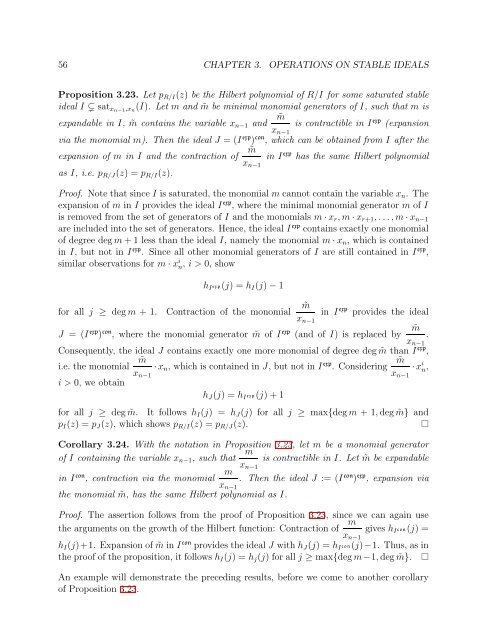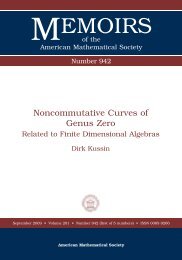University of Paderborn Department of Mathematics Diploma Thesis ...
University of Paderborn Department of Mathematics Diploma Thesis ...
University of Paderborn Department of Mathematics Diploma Thesis ...
You also want an ePaper? Increase the reach of your titles
YUMPU automatically turns print PDFs into web optimized ePapers that Google loves.
56 CHAPTER 3. OPERATIONS ON STABLE IDEALSProposition 3.23. Let p R/I (z) be the Hilbert polynomial <strong>of</strong> R/I for some saturated stableideal I sat xn−1 ,x n(I). Let m and ˜m be minimal monomial generators <strong>of</strong> I, such that m is˜mexpandable in I, ˜m contains the variable x n−1 and is contractible in I exp (expansionvia the monomial m). Then the ideal J = (I exp ) con , which can be obtained from I after the˜mexpansion <strong>of</strong> m in I and the contraction <strong>of</strong> in I exp has the same Hilbert polynomialas I, i.e. p R/J (z) = p R/I (z).x n−1Pro<strong>of</strong>. Note that since I is saturated, the monomial m cannot contain the variable x n . Theexpansion <strong>of</strong> m in I provides the ideal I exp , where the minimal monomial generator m <strong>of</strong> Iis removed from the set <strong>of</strong> generators <strong>of</strong> I and the monomials m · x r , m · x r+1 , . . . , m · x n−1are included into the set <strong>of</strong> generators. Hence, the ideal I exp contains exactly one monomial<strong>of</strong> degree deg m + 1 less than the ideal I, namely the monomial m · x n , which is containedin I, but not in I exp . Since all other monomial generators <strong>of</strong> I are still contained in I exp ,similar observations for m · x i n, i > 0, showfor all j ≥ deg m + 1.x n−1h I exp(j) = h I (j) − 1Contraction <strong>of</strong> the monomial˜mx n−1in I exp provides the idealJ = (I exp ) con , where the monomial generator ˜m <strong>of</strong> I exp ˜m(and <strong>of</strong> I) is replaced by .x n−1Consequently, the ideal J contains exactly one more monomial <strong>of</strong> degree deg ˜m than I exp ,i.e. the monomiali > 0, we obtain˜mx n−1· x n , which is contained in J, but not in I exp . Consideringh J (j) = h I exp(j) + 1˜mx n−1· x i n,for all j ≥ deg ˜m. It follows h I (j) = h J (j) for all j ≥ max{deg m + 1, deg ˜m} andp I (z) = p J (z), which shows p R/I (z) = p R/J (z).Corollary 3.24. With the notation in Proposition 3.23, let m be a monomial generatorm<strong>of</strong> I containing the variable x n−1 , such that is contractible in I. Let ˜m be expandablex n−1in I con m, contraction via the monomial . Then the ideal J := (I con ) exp , expansion viax n−1the monomial ˜m, has the same Hilbert polynomial as I.Pro<strong>of</strong>. The assertion follows from the pro<strong>of</strong> <strong>of</strong> Proposition 3.23, since we can again usemthe arguments on the growth <strong>of</strong> the Hilbert function: Contraction <strong>of</strong> gives h I con(j) =x n−1h I (j)+1. Expansion <strong>of</strong> ˜m in I con provides the ideal J with h J (j) = h I con(j)−1. Thus, as inthe pro<strong>of</strong> <strong>of</strong> the proposition, it follows h I (j) = h j (j) for all j ≥ max{deg m−1, deg ˜m}.An example will demonstrate the preceding results, before we come to another corollary<strong>of</strong> Proposition 3.23.
















